The Kangaroo Islanders: A story of South Australia before colonisation 1823
When the South Australian Company landed on Kangaroo Island in 1836 to begin the official settlement of the province, they were surprised to find several others were already living there. William Cawthorne, writing in 1854, tells of some of these people, voiced in regional English dialects and rich with nautical expressions honed through their sea life.
READ REVIEW
↓
The Kangaroo Islanders:
A story of South Australia before colonisation 1823
WA Cawthorne, edited by Rick Hosking | April 2020
William Cawthorne’s factually-based narrative written in 1854 treats the ‘deeply dyed sins of the Kangaroo Islanders’ (p.107) of the early nineteenth-century.
Rick Hosking’s book – based on his 2003 PhD thesis and subsequent research – includes an introduction to Cawthorne’s nineteen-chapter tale, which is described as the ‘first book written about Kangaroo Island’ (p. ix). Hosking’s notes, a selection of Cawthorne’s watercolours, and Hosking’s essay ‘Beyond the pale’ follow. Kangaroo Island was considered the Ultima Thule, the land beyond known civilisation, outside accepted behaviour, not holding to the laws of the land. Cawthorne’s story is of the captain of a brig in search of salt and skins, whose crew becomes entwined in misfortunes on the island. The crew’s arrant cruelty to Islanders and animals is not incidental; it raises ire in the reader.
William Anderson Cawthorne (1825–97) was an Adelaide schoolmaster and social commentator. Among his tale’s many nautical terms is a geometry lesson: the sailing vessel ‘appeared a beautiful complex geometrical problem, a series of isosceles, equilateral, and scalene triangles ... made up of ropes and spars’ (p. 9). Cawthorne’s descriptions of the mutable sea and sky are lyrical. He was the son of the first keeper of the Sturt Lighthouse on Kangaroo Island (operated from 1852), which he visited six times over eleven years. The Islanders was serialised in the Illustrated Melbourne Post from 1865 to 1866, published by Rigby (Adelaide) in 1926 as The Kangaroo Islanders, and reprinted in 1996 by the Islander Newspaper Group.
The story is a rollicking scaffold on which Hosking builds – in seventy-nine pages of close and very valuable notes – a critical history of the period. Hosking wrests fascinating details from hearsay, tall tale and oral ‘history’, first-hand experience, government archives (including from Cawthorne’s mariner father’s lighthouse journal), and current anthropology and histories.
The reproduction of fourteen somewhat lack-lustre watercolours by or attributed to Cawthorne seems gratuitous, as most don’t contribute directly to the story. Far better to have included from the same Mitchell Library collection ‘The Althorpes’, the island group where one of the dastardly deeds occurred and is described, and, especially, Cawthorne’s panoramic view of Creek (Antechamber) Bay, ‘A view on Kangaroo Island’, the domain of Nat Thomas (Old Sam in the tale). Further, the factual truths in Cawthorne’s story require a good map to locate places and actions along the Kangaroo Island and mainland coasts, to help those unfamiliar with the region’s geography and negate the idea that Cawthorne’s is a ‘treasure island’ adventure, which it certainly is not.
Cawthorne talks about Aboriginal women who were taken to Kangaroo Island from Tasmania and from South Australia’s mainland. His core theme is these women’s forms of active and passive resistance to their mistreatment by the European Islanders who forced them to work in the seal and wallaby pelt trade they ran with passing ships.
Hosking’s essay ‘Beyond the pale’ (pp. 199-248) expands his previous consolidations of this subject. In this strong essay he discusses the murder of George Meredith junior. Meredith, the eldest son of a highly successful Tasmanian free settler, lived with an Aboriginal woman on South Australia’s coast. He was killed by Aboriginal people in 1836, just before official settlement began. This contributed, Hosking says, to the European idea that Indigenous people were untrustworthy, irrational and ‘inexplicably’ violent. This ‘helped soothe European consciences uneasy about Aboriginal dispossession and disadvantage’ (pp x-xi).
Hosking also points out that Cawthorne’s maritime orientation was unique at the time. Other writers were ‘turn[ing] their faces inland’ to the bush to describe the colonial experience (p. 201). Many historians are grateful for Cawthorne’s alternative viewpoint.
Reviewer: Bridget Jolly, PHA (SA)
Kangaroo Islanders is published by Wakefield Press.

